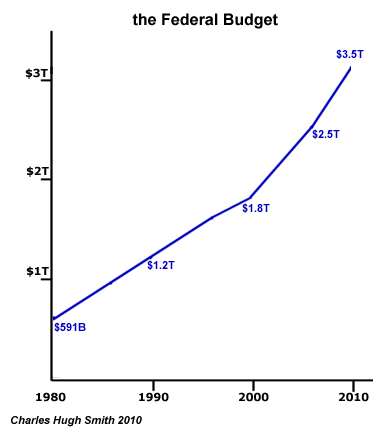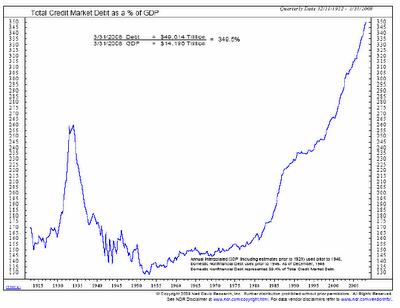1968 and 1980: Republicans, Democrats and Debt
 Courtesy of Charles Hugh Smith, Of Two Minds
Courtesy of Charles Hugh Smith, Of Two Minds
Democrats in 1968 and Republicans in 1980 shared the same game plan: guns and butter, paid for by immense borrowing.
About the only benefit of being a political junkie is being able to recall events and contexts which have been lost to all but history majors. To bypass the tiresome partisan "debate" (is a dog chasing its tail a "debate"?) over "who’s to blame for everything going to heck, Obama or Bush," let’s place the last 9 years in context by glancing at a few charts.
Here is a chart of Federal spending starting with the Republican Era of "small government" in 1980. Though it may seem to the casual observer that the Republican reign was interrupted by 8 years of Clinton, this would be a grave misunderstanding. Yes, the political labels of "Democrat" and "Republican" were switched on the White House, but the underlying "move to the center" via championing smaller central government continued uninterrupted during the Clinton era.
Indeed, Clinton reduced the Federal head count and reformed Federal welfare programs far more successfully than any Republican.
But what this chart makes abundantly clear is what a travesty of a sham it is for either party to claim the crown of "small government:" Federal budgets have exploded in a 25-year long era of low inflation and declining interest rates.

If the Republicans were serious about "small government," there is scant evidence of it here, even when they controlled the White House and Congress.
Next up: the famous chart of total U.S. debt measured in GDP:

The left-hand spike is the Great Depression: debt did not skyrocket during the GD, GDP collapsed, driving the ratio of debt to GDP into a spike. Let’s look at a clearer snapshot of the same data:

Note the tiny blip created by massive Federal borrowing and spending to fund a global war–World War II. As GDP exploded upward with the stupendous war effort, the actual rise in debt vis a vis GDP was modest indeed.
This gives the lie to the Keynesian argument that borrowing trillions of dollars now is perfectly sustainable and right because it "worked" in 1942-45. Borrowing trillions (in today’s dollars) "worked" because GDP skyrocketed along with the debt. But now, we as a nation are borrowing unprecedented sums and GDP growth is at best anemic and at worst mere statistical legerdemaine.
Put these charts together and you are forced to conclude the ruling ideology of both parties is "borrow and spend." The entire project of "small government" was a hoax; spending never decreased, it simply skyrocketed in "entitlements" favored by middle-class and older voters–the populace who votes at higher rates than younger citizens.
While various "ideological" conflicts arise from essentially trivial Federal programs like the Department of Education ($45 billion), there are never any real conflicts over the "gummit sends out checks" programs (Social Security, $700 billion, Medicare/Medicaid, $800 billion) or over borrowing to buy both butter and guns (Pentagon, $670 billion).
1968 and 1980 were watershed years. In 1968, the Democratic program of expanding both "guns" (the Vietnam War and the Cold War) and "butter" (various entitlements like Medicare and other social programs like Housing and Urban Development) accelerated the structural rot at the heart of the U.S. economy.
But Federal expansion and borrowing were only part of the context of decline. Funny little cars with names like Datsun and Honda started appearing–global competition arrived just as U.S. manufacturers became complacent. The era of endless cheap oil came to a sudden end a few years later when a Mideast oil embargo pressed home the point that the U.S. was no longer energy-independent.
(Oh, wait–I forgot! Oil and gas remain endless and cheap. Silly me.)
The great post-war Bull market topped out in 1966. In 1968, it still seemed as if the nation could borrow endless sums without consequence. But beneath the partisan rancor of the times, the structural rot was eating away at the foundations of U.S. prosperity.
12 years later, a wrenching 14-year long Bear market and stagflation had raised interest rates even as it had gutted incomes and confidence. By appointing Paul Volcker, Ronald Reagan effectively slew the inflation dragon with interest rates of 16%, enabling 30 years of low-interest borrowing by the Federal government, corporations and private citizens.
This heady brew of declining rates and expanding credit created the explosion of public and private debt traced out in the second chart.
Republicans like to claim credit for the re-energizing of U.S. prosperity, but beneath the self-congratulatory back-slapping the truth is quite different: it was the computer, software and network revolutions launched by misfits, outsiders, nerds with hippie values and other marginalized creatives which laid the foundations of rising prosperity via rising productivity and the growth of new real industries.
Please see the book What the Dormouse Said: How the 60s Counterculture Shaped the Personal Computer for more on the real roots of the computer, software and network revolutions.
The bogus "prosperity" created by expansion of credit and debt launched by the "Reagan Revolution" in 1980 is about to bear bitter fruit indeed. Now that stupendous expansions of credit and debt no longer boost GDP commensurately, growth remains flat to down while debt explodes ever higher.
The futility of this project–to "grow" via endless exponential expansion of credit–is about to be revealed. Perhaps the recent failed auction of 30-year Treasury bonds– it seems few but the Federal reserve want to gamble that interest rates will stay near-zero for the next 30 years–is the first precusor of the coming collapse of the exponential debt project.


